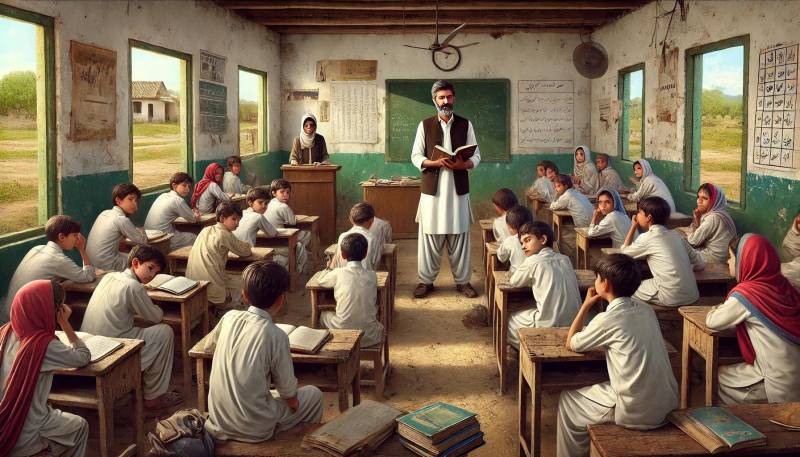
Primary education establishes a fundamental base because it forms the foundation through which children progress from school to their careers. This building block is woefully undernourished in Pakistan, especially in government schools. Weak initial education results in student failure that obstructs their academic journey. Recently I had the privilege of visiting the government schools in Rawalpindi district under the project NIETE National Institute of Excellence on Teachers Education which is part of an NGO based in Islamabad named Taleemabad. This NGO is working on different educational projects and NIETE is one of them with the collaboration of the Federal Directorate of Education Islamabad. The purpose of this project is to assess the student's learning level and classroom observation till the primary classes. Through my observations, I have identified several issues that undermine the efficiency of primary education at government schools despite offering consistent monitoring and relevant knowledge.
The major issue that emerges mostly is teacher demotivation posing a threat to the learning environment, mainly the primary level. Teaching staff take up classroom positions instead of offering active learning supports that benefit their students. These teachers only demonstrate higher performance when government organisations visit or when interventions like the National Institute of Excellence on Teachers Education (NIETE) occur. It highlights that most of these teachers are capable enough but there are behavioral issues with them. The irregular commitment to teaching between various educators produces unsatisfactory results in student achievement and deteriorates classroom participation.
With this, these teachers also use corporal punishment to handle the classroom disturbances although this practice remains problematic. This approach to handling the classroom not only undermines the children's confidence but also vanishes their willingness to learn, consequently the learning environment deteriorates. Along with this the government also displays minimal care and attention toward its primary education system. Present government education policies invest most resources into constructing new facilities despite neglecting the direct educational needs of students who learn in classrooms. Each primary school teacher faces an excessive workload because they need to manage two to three classes at once due to insufficient numbers of teaching staff. Such insufficient staffing binds teachers with reduced motivation and creates obstacles in their teaching practices.
In rural areas, cultural traditions restrict educational opportunities mostly affecting female students in those territories
Further, there are a lot of disparities between rural and urban schools which again compounded the challenges. Urban schools have superior facilities and administrative backing as opposed to rural schools while their teaching staff members typically deal with extra responsibilities. The teachers bear the responsibility of executing multiple administrative assignments that involve contributing to polio vaccination drives, censuses, and conducting multiple surveys. For instance, one of the school principals is the district head of the plantation committee and he has to go for that administrative task while the school is left behind to one of the teachers hence the school matters remain unresolved. Excessive responsibilities interfere with their teaching abilities making them less effective educators within the classroom environment.
The societal perception regarding government schools stands as another vital problem in the educational system. The distrust of parents toward schools stems from their belief that educational institutions maintain low moral values and minimal care from an average teacher. Although government schools are quite affordable, with fees ranging from 50 to 100 rupees per month, parents remain reluctant to enroll their children. They choose private schools, which are viewed as maintaining higher ethical and moral standards, along with superior teaching practices.
In contrast, urban rural schools have their own set of challenges. In rural areas, cultural traditions restrict educational opportunities mostly affecting female students in those territories. The combination of cultural boundaries with religious traditions remains a major barrier for girls as they seek access to their education. With this, rural areas in Rawalpindi have become surrounded by housing societies making many local people rely on these developments to meet their economic needs. The priority of financial gain makes parents choose to involve their children in their business rather than focusing on their education such as milk distribution businesses.
Experts agree that effective solutions to primary education problems in Pakistani government schools require a complete system-wide and multi-directional strategy. The stakeholders need to make primary education revitalisation their top priority because fundamental primary education forms the basis for academic success and professional achievement in children.
The enhancement of teacher motivation ranks as the most important step. Reliable professional development programs should target both effective teaching methods and classroom control skills to accomplish this objective. Further, the government needs to deal with the discrepancy between teachers and students and must employ excess qualified instructors because smaller classroom ratios lead to improved student results. When teachers receive improved attention toward students they can enhance learner involvement and successful academic outcomes.
Further, the government should maintain equal attention to both infrastructure development and actual student requirements in educational policies. Participation from educational experts combined with parents and community members during policy creation allows the identification of true educational requirements. Resources should be allocated not only for physical infrastructure but also for learning materials and extracurricular activities that foster holistic development.
To address societal perceptions of government schools, awareness campaigns that highlight successful programs and positive outcomes can be effective. In rural areas, targeted initiatives are essential to confront cultural barriers to education, particularly for girls who face unique challenges. Community outreach programs involving local leaders can significantly increase awareness of the importance of education and actively promote gender equity in schooling. Furthermore, financial support mechanisms such as scholarships or stipends for low-income families can effectively help alleviate the economic challenges that impede access to quality education. In conclusion, a collaborative effort among government authorities, educational institutions, communities, and parents is vital for transforming primary education in Pakistan. By implementing these comprehensive recommendations, we can create an educational environment that not only supports but also empowers every child to establish a solid foundation for their future academic and personal success.

